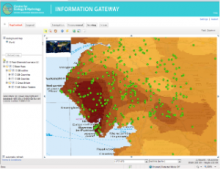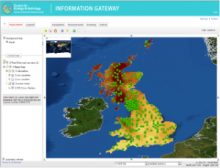Post Chernobyl surveys of radiocaesium in soil, vegetation, wildlife and fungi in Great Britain
 |  |
| Abstract | Data comprise radiocaesium concentrations in soil, vegetation, wildlife and fungi analysed from samples collected from throughout Great Britain after the 1986 Chernobyl accident by the Centre for Ecology and Hydrology (CEH), formerly the Institute of Terrestrial Ecology (ITE). National level vegetation surveys were conducted in May 1986, October 1986 and Spring 1987. More intensive surveys of vegetation (grass and heather) and wildlife (grouse, fox, etc.) in restricted areas were carried out in Cumbria, Wales and North Yorkshire in 1989, 1990, 1991 and 1993. Surveys of fungi were carried out between 1994 and 1997. The data are suitable for interpolation to create spatially variable surfaces suitable for input into models. | |
| STAR partner | NERC-CEH | |
| Type of data | Research | |
| Sample number | >2500 | |
| Quality | Vegetation was clipped from 1 metre squared quadrats to a height of 1 centimetre above ground level. Samples were dried at 80 degrees centigrade, weighed, ground and counted in plastic containers (130 millilitre) on a NaI(T1) detector to determine the radiocaesium activity. The most active samples were recounted on a high resolution germanium detector. Soil type was noted at each site (Soil survey 1983). Soil samples were allocated to a series of textural categories (Clay (particles of less than 2 m in diameter); Silt (particles of 2-40 micron diameter); Sand (particles of 50 micron -2millimetre diameter); Organic (humified plant material); Loam (significant quantities of material from 3 or more categories). Soil pH was determined using an antimony electrode pH meter. Animal samples consisted of necks and rumen contents from 70 red deer (Cervus elaphus), whole bodies of three species of lagomorphs (25 rabbits (Oryctolagus cuniculus) and 2 black hares (Lepus capensis), two species of grouse (13 red grouse (Lagopus lagopus), 4 black game (Tetrao tetrix), and 22 foxes (Vulpes vulpes) totalling 141 flesh and 94 gut samples. Samples of flesh were removed from the neck of the deer, from the legs and back of the hares, rabbits and foxes, and from the breast muscle of the grouse. These were weighed fresh and placed in standard counting containers which were kept in a deep freeze until required for analysis. Each sample was thawed for 24 hours prior to counting. Samples were analysed by high resolution gamma spectrometry using either hyperpure germanium or germanium lithium detectors with relative efficiencies of 20 to 25 percent. Counting times varied between 25k to 80k seconds. Detectors were calibrated. | |
| Spatially referenced | Yes | |
| Ecosystem type | Terrestrial | |
| Sample type | Soil, vegetation, wildlife and fungi | |
| Date | Between 1986 and 1997 | |
| Languages | English | |
| Status | Completed study | |
| Obtain data | Freely available from the CEH Environmental Information Portal: https://doi.org/10.5285/d0a6a8bf-68f0-4935-8b43-4e597c3bf251 | |
| Key reference sources | Chaplow, J.S., Beresford, N.A., Barnett, C.L. (2015). Post Chernobyl surveys of radiocaesium in soil, vegetation, wildlife and fungi in Great Britain. NERC-Environmental Information Data Centre doi:10.5285/d0a6a8bf-68f0-4935-8b43-4e597c3bf251 Chaplow, J. S., Beresford, N. A., and Barnett, C. L.(2015) Post-Chernobyl surveys of radiocaesium in soil, vegetation, wildlife and fungi in Great Britain, Earth Syst. Sci. Data, 7, 215-221, http://doi.org/10.5194/essd-7-215-2015, 2015.Wright, S.M., Beresford, N.A. & Scott, W.A. (2004) Application of a Monte-Carlo model to post-Chernobyl restricted areas in west Cumbria and north Wales. Report to the Food Standards Agency. | |
| Data ownership | NERC-CEH | |
| Database format | csv | |
| Figure information | ||
| Keywords | chernobyl , united_kingdom , infoex | |
Prepared by STAR NoE
